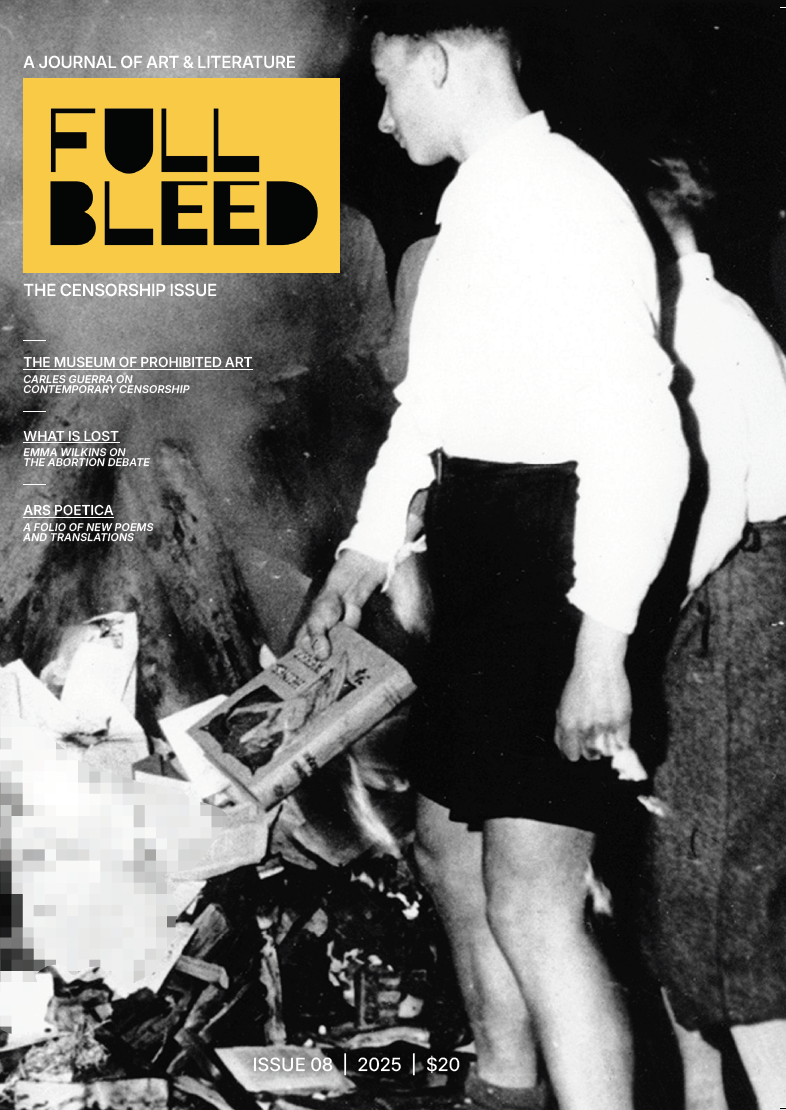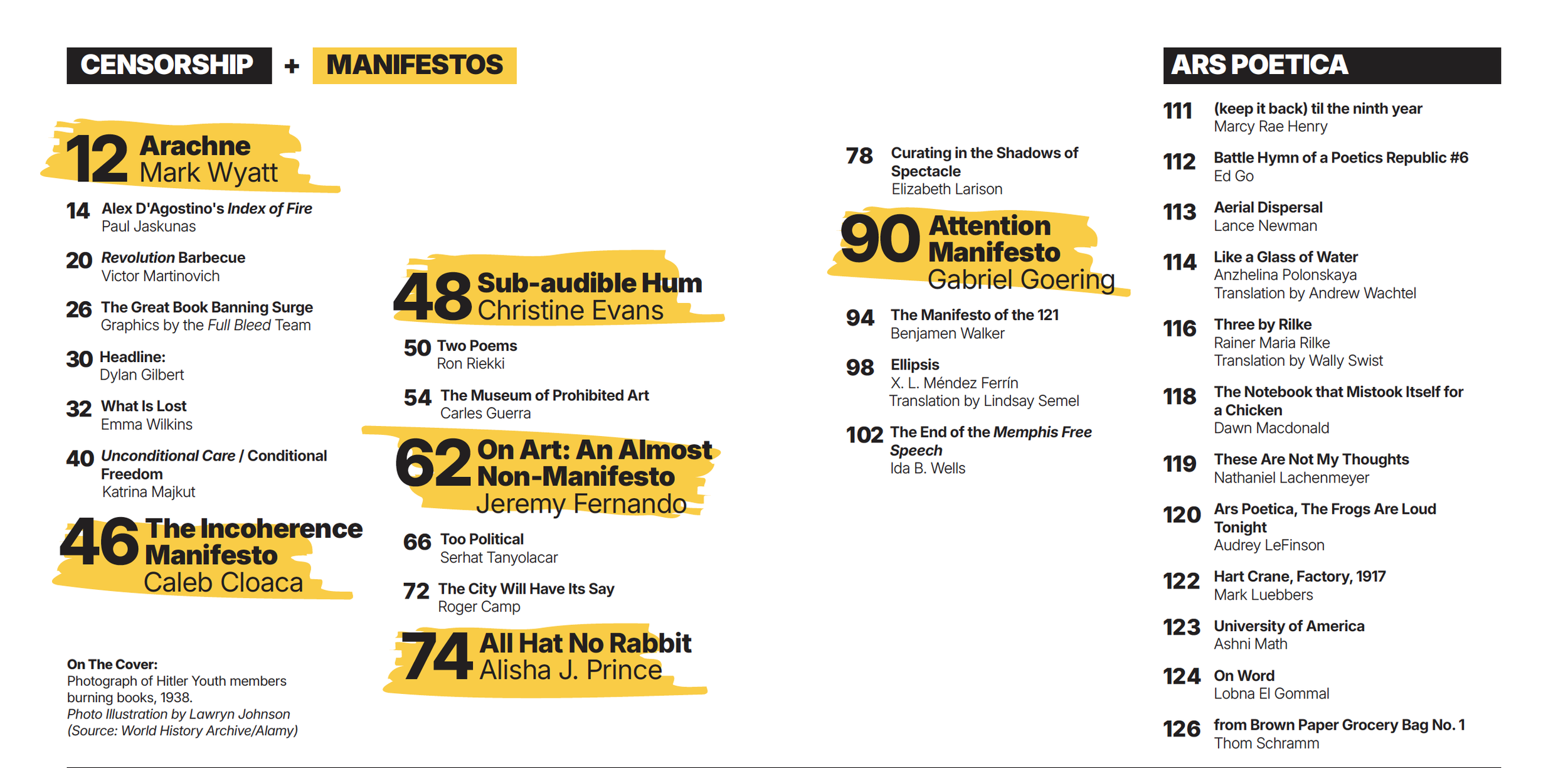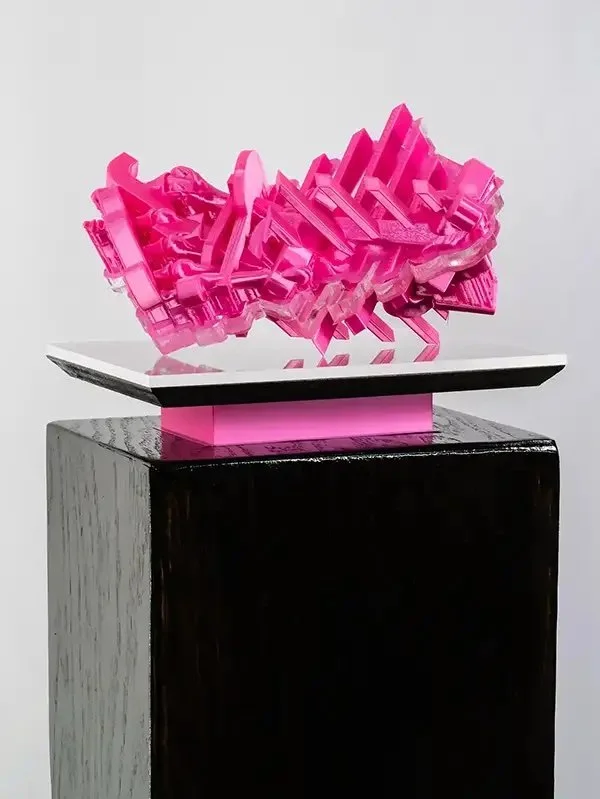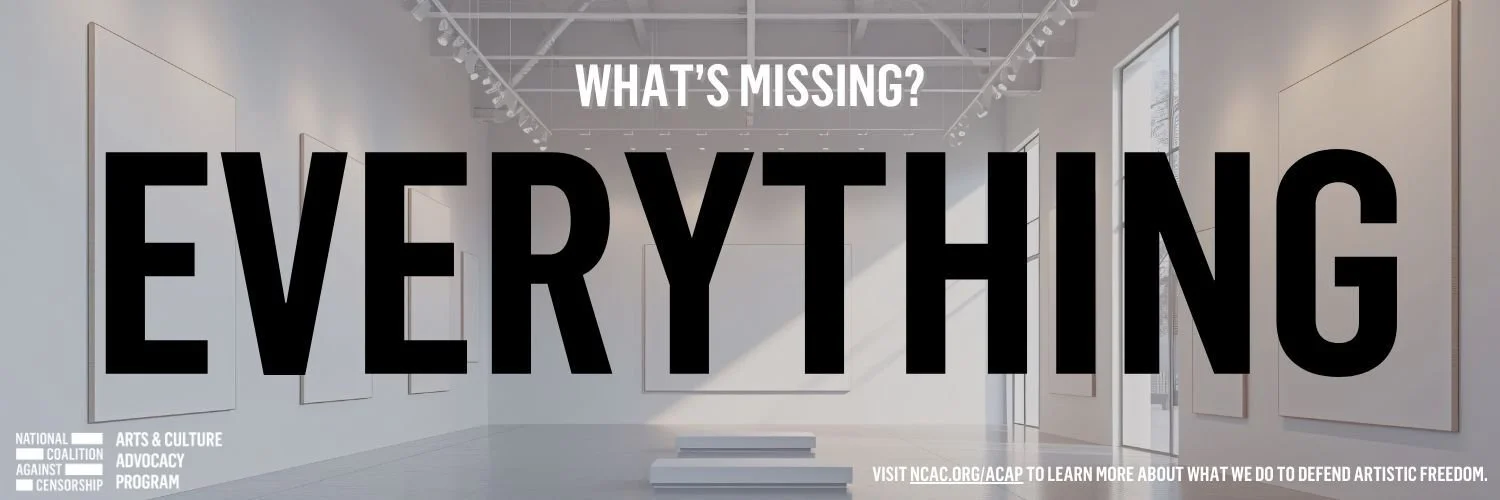Issue 08
Alexander D’Agostino, An Index of Fire, 2024. Courtesy of the artist.
Censorship | Manifestos | Ars Poetica
In Full Bleed 8, you’ll find stories of censorship from the United States and around the world. As artists and writers face new restrictions on freedom of expression, this timely issue explores the logic of contemporary censorship, case studies in curating controversial work, and the experiences of recently censored artists. The issue also features several brief yet urgent manifestos for our time and a special folio of ars poetica poetry.
With work from Alexander D’Agostino, Christine Evans, Carles Guerra, Marcy Rae Henry, Elizabeth Larison, Katrina Majkut, Ida B. Wells, and Emma Wilkins, among many others, this one’s a keeper.
Full Bleed 8 is available in full-color print and digital editions beautifully designed by students at the Maryland Institute College of Art.
Editor’s Letter
We Are Not Free
The idea of devoting this year's issue to the censorship surfaced in March 2024, after Guernica published Israeli writer Joanna Chen's essay about struggling to find common ground with Palestinians after the October 7 attacks. Incensed by the essay's appearance on Guernica's site, several staff members resigned in protest, prompting the editor to retract the piece. By then, there was nothing unusual about Guernica’s failure of nerve; its capitulation to political pressure had been preceded by several cases in which institutions had deplatformed critics of Israel. By the spring of last year, the accumulation of such incidents made clear to us that censorship in contemporary culture was a phenomenon that deserved closer attention.
Since then, the willingness to appease, to placate, and to avoid conflict with censors has only become more commonplace. Every college administrator has been put on notice that Trump's minions have their hands on the spigot controlling the flow of federal dollars into the halls of academe. No surprise, then, that universities have scrambled to conceal, rename, or dismantle programs that could attract disapproval anywhere near the White House—where, predictably, the hypocrisy has been as flagrant as ever. The President claims to be a defender of free speech, yet his executive orders and actions have stifled expression on numerous fronts. Cultural institutions and non-profits reliant on federal funds are purging their own websites of potentially impolitic language. Some professors and teachers have felt compelled to modify course descriptions and curricula. Even art students have been forced to question whether to make work that could get them or—their schools—in trouble.
The atmosphere of repression may feel new to many of us, but censorship has a long history, glimpses of which can be found in this issue. Here you will find the story of how Ida B. Wells’ newspaper, the Memphis Free Speech, ceased to exist (page 102), fiction censored under the regime of Francisco Franco (page 98), and images of book burnings in Nazi Germany, as transformed in the art of Alex D'Agostino (page 14). We have also included here an artifact from the Red Scare, a time when many in our government—most notoriously, Sen. Joseph McCarthy—were eager to ban “un-American” books and silence communist sympathizers. In that atmosphere of fear, President Dwight D. Eisenhower sent a remarkable letter to the American Library Association, in which he defended the freedom to read (page 29).
The history of censorship may be old, but it operates today in new ways. In our interview with Carles Guerra, artistic director of Barcelona's Museum of Prohibited Art, he argues that censorship is never the end of the story—not in a culture as mimetic as ours, where digital images spread and iterate with unprecedented speed (page 54). If attempts to stifle images lead inevitably to their wider dissemination, why do institutions continue to make the mistake of trying to stifle artists? Surely there is a smarter approach. Elizabeth Larison shows us as much in her case studies of museums that successfully staged exhibitions of controversial artwork, largely without incident (page 78).
One lesson laced through this issue is that when fear does not get the better of us, when we trust our publics and ourselves to cope with the consequences of our own convictions, good things can follow. Wary of being misunderstood, the writer Emma Wilkins reveals that she has long withheld her true thoughts about abortion, yet in her essay here she opens up, calling for a more nuanced discourse on reproductive rights—and connecting that discourse to how we think about climate change, interdependency, and sacrifice. “We are not human despite our interdependence and our limits,” she writes, "we are human because of them." (See page 32.)
Abortion and climate change are subjects of fierce public debate, yet Wilkins’ essay shows us how the language with which we conduct such debates seeps into our most intimate relationships and how we think. Similarly, acts of censorship may target public speech, but their effects can spread quickly into private life. Perhaps, then, resistance can begin with our day-to-day dealings with each other. While editing the issue, I had the pleasure of reading Salman Rushdie's new memoir Knife. Midway through this stirring book, he recalls his childhood in India and listening in on the adults in his family. They would discuss “everything under the sun, from contemporary politics to the existence of God, without feeling any pressure to censor or dilute their opinions.” Their conversations, he writes, taught him “the first lesson of free expression”: “that you must take it for granted. If you are afraid of the consequences of what you say, then you are not free.”
By that standard, many of us are not free. We have increment ally given ground to censors real and imagined. We offer this issue in part to suggest an alternative posture. In addition to features on the theme of censorship, you will find here several brief yet urgent manifestos for our time and a selection of poetry in the ars poetica vein. We hope you enjoy, and are encouraged by, what you find here. Thank you for reading.
-Paul Jaskunas










